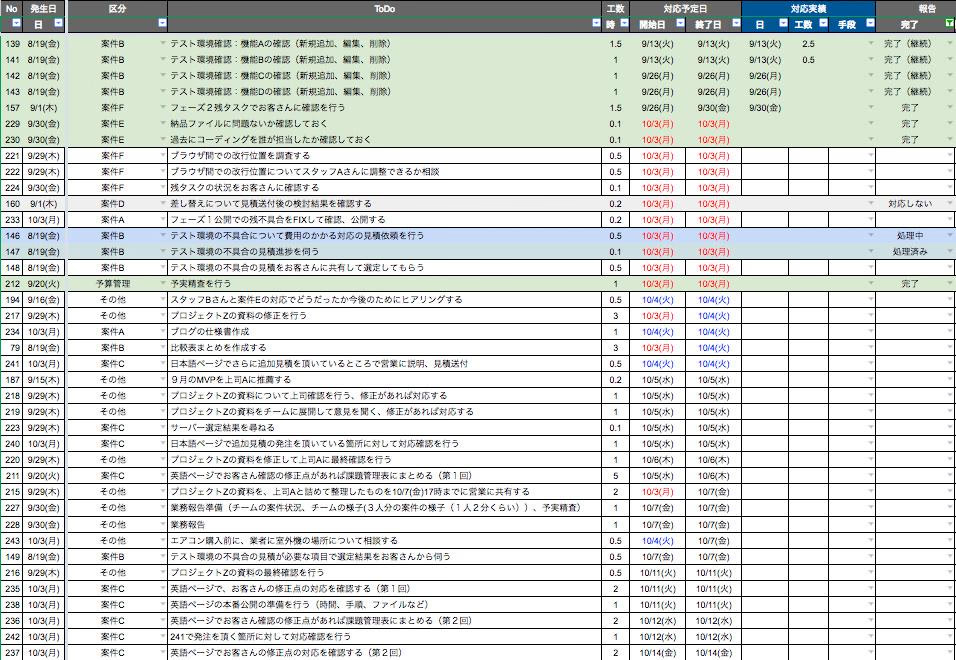こんにちは、ディレクションチームのリーダーを務めている西城です。
ディレクターは、とにかくやることのたくさんある職種です。私の場合は、ディレクション業務だけでなく、チーム運営というリーダーとしての業務もあるため、タスクの優先順位付けはとても大事です。そこで、どんな風に優先順位を決めて日々業務に取り組んでいるかについて、今回はお話ししたいと思います。
どのタスクを優先とするか
現在、私は1つの新規案件と5つの運用案件、さらにリーダーとしての業務を抱えています。
新規案件は規模によって異なりますが、例えば下記のような業務があります。
- 企画書の作成、提案
- サイト構造設計
- ワイヤーフレーム設計
- SEO施策
- 制作スケジュールの設計、進行管理
-
成果物の品質管理
運用案件は、内容によってレベルが異なります。例えば、サイトコンテンツの不定期・定期更新、Googleアナリティクスの解析レポート作成、システム障害のサポート、新規に英語ページ対応やレスポンシブ対応など、対応範囲によって実働する工数が異なります。
リーダーとしての業務は、予算と実績の精査、請求書処理、スタッフが働きやすいような環境づくりの施策と実施、採用活動などがあります。
これだけ多様な業務があり、業務の中には様々なタスクがあります。並行して進めるためには、どのタスクを最優先でやっていくべきか考える必要があります。
優先順位を考えるきっかけとなったのが、特に今年5月・6月のピーク時です。2つの新規案件のメインディレクション、1つの新規案件のフォローと3つの運用案件を抱えていました。当時は、2つの新規案件と1つの運用案件の納品タイミングが一緒で、上記のような業務内容を同時期に行う必要が。新規案件では、お客様の本社が会社から往復3時間位かかるほど遠方に位置していたため、毎週の定例と定例に向けての準備、他多数の業務が重なり、毎日終電近くまで働き、日々疲弊していて、週末においては自宅から一歩も外出できないくらいダメージを受けていました。
「緊急ではないが重要なこと」が一つのカギに
そんなときに、上司からヒントを得たのが『7つの習慣』です。
『7つの習慣』は説明するまでもなく世界的ベストセラーで、日本で紹介されてからもう20年も経ちますが、未だに売れ続けているビジネス書です。
タスクには緊急度や重要度で優先順位が異なりますが、この『7つの習慣』の中で、第3の習慣「最優先事項を優先する」を実践してみることにしました。
実践するにあたり、『7つの習慣』でいう4つの領域を考えてみます。

第1領域は、緊急で重要なこと。
締め切りのあるタスクや急なアポイントが該当し、ディレクション業務の場合は、案件のタスクがこれに当てはまります。
第2領域は、緊急ではないが重要なこと。
私の場合は、主にリーダー業務やミッションがこれに当てはまります。
第3領域は、緊急だが重要ではないこと。
会議や報告書、重要ではないメールの処理が該当します。
第4領域は、業務的には特にないので説明を省きます。
『7つの習慣』では、成功のカギを握るのは第2領域(緊急ではないが重要なこと)に投資する時間の確保が必要と説きます。しかし、時間には限りがあります。多くの人は、第2領域を意識せずに緊急で重要な第1領域を優先してしまい、それで一日が終わってしまうことの繰り返しで手一杯になりがちだそうです。
最優先事項を見極める
そこで、第2領域を確保するために、現時点で抱えている全ての業務を細分化して1ヶ月先までのタスクをToDoリストに落とし込んでみました。

※ToDoリストは中川が紹介した課題管理表を少しカスタマイズして使っています。課題管理票の作り方は中川が書いた記事「スプレッドシートを使った、ディレクターのための課題管理表」をご覧ください。
随分と細かいですが、これこそが最優先事項を見極めるための準備となります。
このToDoリストは日々メンテが必要です。
急な予定の変更や、新規に予定が発生する度にメンテを行います。
最初に1ヶ月先まで作った後は、2週間位を見通してToDoを追加します。
定期的なタスクに関しては、一つが終わって次のアクションが必要なものはタスクが終わる度に追加していきます。
例えば、今月末の請求書処理が完了した時点で、対応予定日を来月末とする請求書処理の項目を追加します。
ToDoリストが完成したら、今度は1日の予定に落とし込んでいきます。
私の場合は、月曜に今週後半(木金)の予定を作成し、木曜に来週前半(月火水)の予定を作成しています。そこで重要になってくるのが優先順位です。

※参考までに、1日のスケジュールの立て方は大藪が書いた記事「業務の軸となる1日のスケジュール」をご覧ください。
優先順位は大きく2つに分けられます。
- 他人に依頼して動いてもらう必要があるタスク
-
自分だけで完結するタスク
重要なことは、1の「他人に依頼する」場合は、2の「自分だけで完結する」タスクより優先順位を上げて先に行うことです。
そもそも相手は自分の都合に合わせて動いてはいません。
たとえば、次のシーンを想像してみてください。
社内の営業に相談があるとします。相談内容は、その日中に確認して、後で上司に報告義務がある内容だったとします。
しかし、自分は朝直行でお客様のもとに訪問しなければならない。
さて、どのように動けばいいでしょうか・・・。
結論を先に話すと、朝のうちに相手の予定を見て、連絡がとれそうな時間をチェックしておき、その時間にあわせて電話する等ができれば、仮に営業が午後から外出してしまい、すれ違いで会えなかったとしても、タスクをスムーズに進めることができるでしょう。
しかし、相手とコンタクトをとる予定ではあったものの、オフィスに戻ってから声をかけようと思っている場合は、状況は後手後手にまわり、最悪営業とも連絡がとれず、その日中に上司に報告できない恐れがあります。
そうならないように、他人が関わるタスクは、自分のタスクよりも優先順位を上げる必要があります。
優先順位が決まったら、各領域のタスクの優劣を考えます。第3領域(緊急だが重要ではないこと)は、第2領域(緊急ではないが重要なこと)よりも圧倒的にボリュームが多いですが、第2領域のタスクを優先させるために、バランスよく1日の行動計画を立てます。
まとめ
実際、始めてから1ヶ月半経ちましたが、ここまで細分化してリストに落とし込むような経験がないため、メンテナンスだけでも大変に。正直言うとかなり面倒くさいです(笑)。
特に、予定していた2週間先までの日々のタスクが他案件の急な依頼やアポなどで破綻したときなどは調整するだけでもひと苦労です。すでに計画している他案件のタスクの優先順位を考慮して、改めて計画し直さなければなりません。
ただし、日々のタスクを30分ごとで計画しているため、急な依頼やアポでも、調整は行いやすいですし、細分化されたToDoリストのおかげで、業務の漏れは少ないかなと思います。
まだまだ実践中のところで、正直言うと、このやり方が私に合っているかどうか全く分かりません。でも、トライしてみる価値はあるわけで、ひとまず今やっている方法で習慣化して、思考化できるか試しているところです。
いずれにせよ、最終的なゴールは最優先事項を優先して業務に取り組めることです。時間には限りがあるからこそ、時間は必ず意識してタスクに取り組むことが必要です。その中で最優先事項を見極め、優先して対応していけると、業務をもっと効率よく進めることができるのではと思います。

